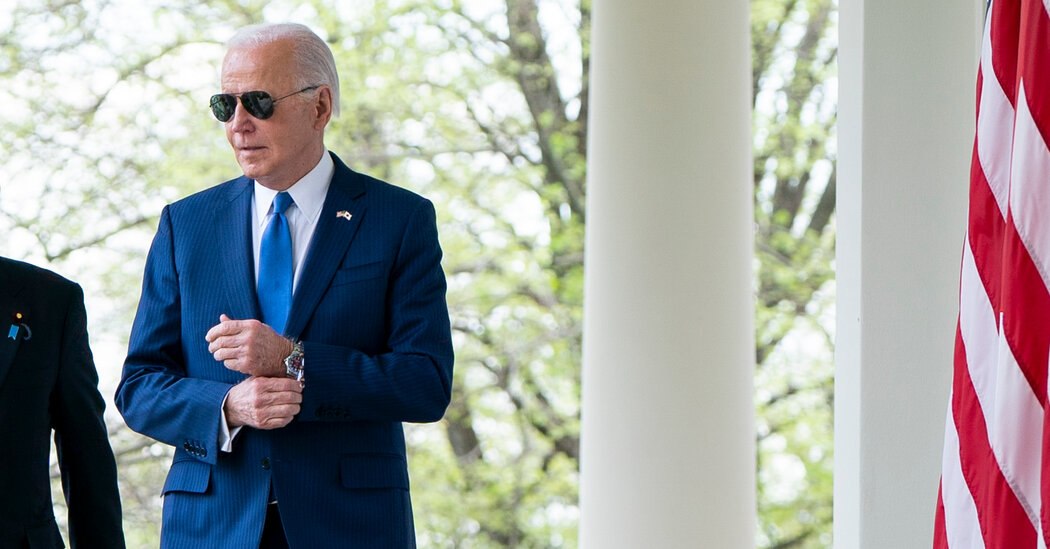Joe Biden is a dapper guy. He always has been. When he turned up decades ago for a first date with the woman who would become his wife and the country’s first lady, her gut reaction was, “This is never going to work, not in a million years.”
Dressed in a sports coat and loafers, Joe Biden was too dapper for someone who had previously gone out with men in T-shirts and clogs.
They worked it out. And the future president stuck to his style. It was one that sometimes skewed Gatsby, for which in 1974 Washingtonian magazine noted his penchant for pinstripe suits and tasseled loafers when citing him as one of the best dressed men in the Senate. It was one that was sometimes too high-toned for its setting. In 1979, Mr. Biden, then a second-term senator, exuded confidence in a “tailored suit and expensive tie” for a campus speech at the University of Alabama, The New Yorker later reported.
It was one that, on occasion, even threatened to upstage the boss. Yes, it must have been flattering to be praised by The Chicago Tribune as the “best-dressed guy” at Bill Clinton’s 2000 State of the Union address. Politically, however, it was not the best look.
Still, dapper cred has stood President Biden in good stead. When Donald J. Trump, now 77, derides his 81-year-old opponent as doddering Uncle Joe, he is missing a point any tailor would be happy to clarify. There is getting old, and there is looking old. To avoid having your clothes add unnecessary years, make style your friend.
“Joe Biden’s style is timeless and doesn’t have any expiration date,” the designer Todd Snyder said recently. If you think that is accidental, you are not paying attention.
Setting aside the occasional solecism (wearing a necktie and not a bow tie with his dinner jacket at the state dinner for Prime Minister Fumio Kishida of Japan), President Biden is consistently the “sartorially elegant” politician Tom Ford once praised in a British GQ interview. More tellingly, he exemplifies how, in politics as in other pursuits, dressing effectively and well requires know-how and a willingness to take a good, hard look in the mirror.
“Bodies change as we age,” said Keith Dorsett, the district manager of Heimie’s Haberdashery, a venerable men’s clothier in St. Paul, Minn. All but the fittest of men are bound to experience a degree of muscle loss across chest and shoulders as they age, along with a loss of flesh across the back and postural shifts. The scale may insist that you weigh just what you did at 30. It cannot account for how some of those pounds turned into a muffin top.
“Think of how seldom we look in the mirror and take a real inventory,” Mr. Dorsett said. “At all times, but particularly with aging, fit is the No. 1 thing.”
That view is endorsed by experts like Giovanni Bianchi, the director of the men’s wear label L.B.M. 1911, maker of what Esquire once called the perfect blazer. “Age is not the defining element of an ability to dress effectively,” Mr. Bianchi said by email from his home in Mantua, Italy. “Age is only the determining factor if you make the wrong choices.”
Alas, strategizing for the dynamics of an aging body requires skills few of us innately possess. Since we are no longer in a world where haberdasheries exist in abundance, what we are left with is the sad tells of aging: a sport coat with scarecrow shoulders, a sleeve drooping past the wrist, trouser hems puddling around one’s shoes.
That is, unless we are President Joe Biden, who clearly retained the lessons picked up at clothiers like Brooks Brothers and Jos. A. Bank (and, presumably, far fancier establishments, though the White House, through a spokesman, demurred when asked which ones). Continuing to refine them even as he occupies the highest office, Mr. Biden gives offhand master classes on the wardrobe tricks that distract from the inevitable predations of time.
“With an older body, you can do what Biden does and put a little structure in the shoulder while keeping it soft, so it’s somewhere between a British and an Italian cut,” Mr. Dorsett said. You can create subtle shaping in the back lining of a jacket where inevitably there is “less meat on the bone as you age.”
You can stick to white shirts with a slightly heightened and moderately spread collar, its points nestled neatly under the lapel. The dual effect both minimizes wattles and creates a tidy frame for the face. You can elect to wear solid color ties and fasten them with four-in-hand or half-Windsor knots that never look like an angry fist at the throat.
You can handily avoid the worst pitfalls of “dressing old,” Mr. Dorsett said, by thinking of the body as defined by its hinges: hips, elbows, ankles, wrists and knees. Have sleeves hemmed at the break of the wrist, he suggested, to avoid the telltale grandpa droop. Trim the skirt of a jacket just a hairbreadth shorter, not in pursuit of Thom Browne styling but to avoid looking as though you bought back your ’70s blazer from a thrift shop bargain rack.
“The bottom line about dressing is that our clothes have a message to send,” Sid Mashburn, a onetime J. Crew and Ralph Lauren designer who now operates a chain of namesake stores, explained from his Atlanta headquarters. “They are a far bigger representation of that than anyone wants to acknowledge.”
Yet why admit to being a billboard? Isn’t saying more by doing less key to style evolution? Is subtlety not the least appreciated of superpowers? If there is anything that distinguishes the style of the man occupying the Oval Office, it is how all but imperceptibly he has learned to dress in a manner that seems simultaneously approachable and commanding, dignified yet not remote, venerable yet vigorous and remarkably fashion savvy.
The blue Mr. Biden favors in his suiting, for instance, is a hue considerably brighter than the funereal navy typically favored by heads of state — one not incidentally forgiving of aging skin. It is also a color very close to the blue on which the stars in the American flag are arrayed. Its Pantone name is Old Glory.
Was its selection a coincidence or else a shrewd bit of presidential semiotics? For that you’d have to ask the dude in chief.
Sumber: www.nytimes.com












